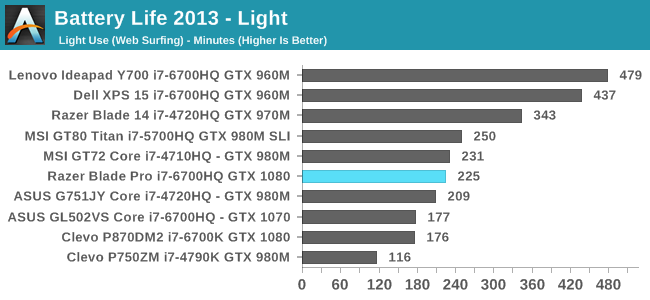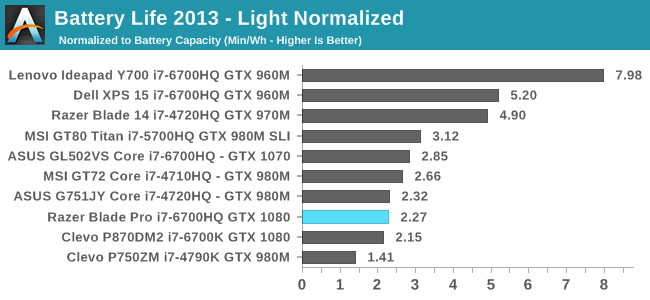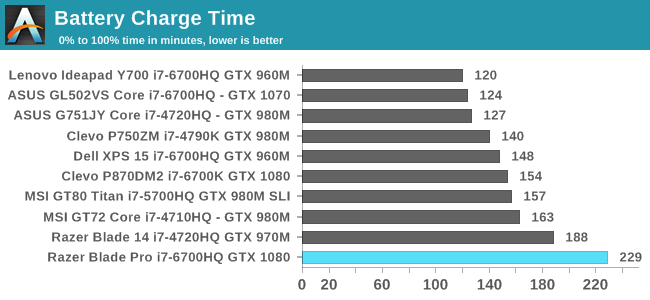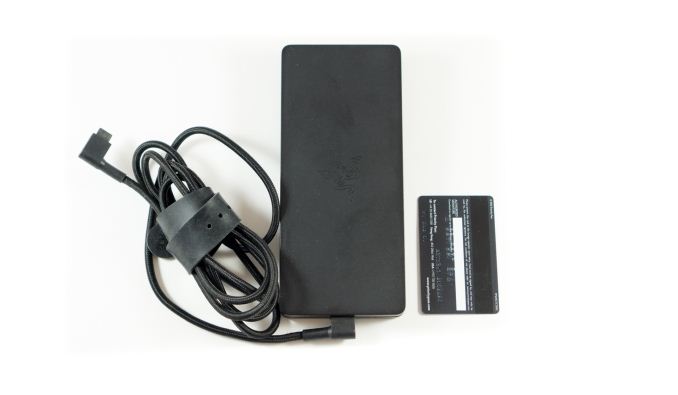The 2016 Razer Blade Pro Review
by Brandon Chester on March 6, 2017 8:00 AM EST- Posted in
- Laptops
- Razer
- Razer Blade Pro
Battery Life
It's fairly well established at this point that gaming laptops and other desktop replacement machines act more like highly portable all-in-one computers than laptops. That is to say, the battery life that you can expect when really making use of the laptop's hardware is incredibly short. With that being said, there's no reason why a gaming laptop shouldn't be able to offer decent battery life for lighter tasks like surfing the web and watching videos. Due to the static power consumption of the system it's unlikely to achieve the same sort of battery life that an ultrabook would, but users should at least be able to do web surfing or get through a movie before having to recharge.
To characterize the Blade Pro's battery life in these types of situations I've run it through our two web battery tests and our video playback test. As always, the display was set to 200 nits in order to keep results comparable between devices. To ensure consistency with the experience that other Blade Pro users will have, the testing was done using Razer's included color profile rather than the more accurately calibrated profile that I generated for the review, as the different appearance for each profile can have an impact on the power consumption if power-saving measures like content-adaptive backlight controls are utilized.
2013 Light Battery

In the old 2013 battery test the Blade Pro comes in at 225 minutes, which is 3.75 hours, or 3 hours and 45 minutes if you prefer that form. This is right in the middle of the chart, but if you compare it to other laptops that use GTX 1070 and GTX 1080 you'll find that it actually leads by a significant margin. A slightly unfair but relevant comparison is to the Clevo P870DM2, which is a desktop replacement machine that is considerably larger and heavier, but also has a desktop i7 CPU and a smaller battery. The Clevo lasts just under three hours, so the Blade Pro has an advantage if you're looking for an incredibly powerful laptop that can be used for some time off of a charger.
2016 Web Battery

In the newer 2016 web browsing test the Razer Blade Pro lasts almost exactly as long as in the older 2013 test. This would suggest that the additional workload of the newer web test is not really relevant next to the static power consumption of the laptop, and if that is the case, users should be able to expect similar battery life for all lightweight tasks.
Normalized Battery Life


While not directly relevant to consumers, it's interesting to look at a device's battery life as a function of its battery capacity in order to get an idea of how efficient it is. As you can see, while the Blade Pro does last longer than the Clevo P870DM2 in our web browsing tests, it did so with the help of a larger battery, and the normalized battery life relative to the capacity of the battery is very similar. It's worth noting that the Blade Pro achieves this with a UHD display, while the Clevo was tested with a 1080p panel, and so I would argue that Razer's result is the more impressive of the two. Of course, the Clevo is disadvantaged by using a desktop CPU, but being able to scale down power for light workloads is necessary for a laptop.
Tesseract Score


In our video playback battery test the Blade Pro comes in at 3.88 hours, which is ever so slightly longer than the web tests which clocked in around 3.75 hours. This is a pretty solid confirmation that the Blade Pro's battery life will be consistent for all these light workloads, as the additional power consumption of a lightweight task is small relative to the fixed platform power of the laptop. As for the Tesseract score, the Blade Pro can't last long enough to get through two cycles of a 143 minute movie, which is a fairly standard length for a movie nowadays, so I'd recommend keeping the power supply handy.
Based on these tests, one can conclude that the Razer Blade Pro provides between three and four hours of battery life for general lightweight tasks like web browsing and watching videos. Razer isn't able to take advantage of Optimus because of the inclusion of G-SYNC, so you're always running off the GTX 1080. With heavier workloads that make greater use of the GPU I've found that the battery depletes rapidly, so I don't recommend trying to play a game without the laptop being plugged in. However, having four hours of battery life is honestly not that bad for such a high performance machine, and it compares favorably to desktop replacement machines from other vendors because, in addition to lasting longer, the total mass of the Blade Pro and its power supply is still much less than a DTR from Clevo or MSI on its own.
Charge Time
The 2016 Razer Blade Pro comes with a 250W power supply, and given that you can only expect a few hours of usage at best, it's one that you'll want to keep with you. Thankfully, it's not incredibly thick like the power supply for Clevo laptops, so it can fit into the inner pockets of many bags without much difficulty. It is still relatively heavy compared to something like Apple's 85W MacBook charger though, so it's a good idea to take it into consideration when deciding whether you want to carry the Blade Pro somewhere.

The Blade Pro has a 99Wh battery which is the biggest battery Razer could ship while complying with airline regulations. With such a large battery and a 250W PSU, the charge time is naturally going to be longer than something like the Clevo P870DM2 which only has an 82Wh battery and a 330W PSU. Having actually used Clevo's power supply, I will say that Razer's solution is basically half the size and mass, and I think that having a slightly longer charge time is worth it to avoid further increases to the mass of the laptop + PSU combo. You can see the size of the Blade Pro charger in the image above, with a credit-card sized card for reference. Additionally, you'll almost always have the Blade Pro plugged in anyway, so a slightly longer-than-average charge time really doesn't present a real-world problem.











57 Comments
View All Comments
Notmyusualid - Tuesday, March 7, 2017 - link
Lovely machine.They should hire you for product development!
I'd add only this, the screen: 4k too high, 60Hz too low.
I think I could live with that CPU, but not the screen.
I'm on my 6th DTR, and I'm now longing for something like this...
Peace.
scook9 - Tuesday, March 7, 2017 - link
One issue I have with this review is the SUPER light touch when it came to the cooling performance. Razer laptops are super suave for sure and look great but for the last few years their cooling performance has been just about garbage. As you noted with the marketing driven design, cooling also suffers due to the need for "thinness" - I am speaking from painful experience here. I have a 2015 Razer Blade that I really liked except for when I had to use it.... Opening chrome would cause the fans to max and the CPU to throttle. It couldn't play Diablo 3 without my tuning the crap out of the CPU and game settings or else throttling and very unstable FPS would occur, never mind the nearly full speed fans at all times. I had to underclock and undervolt the CPU just to stop the throttling, fans were never great.When you review a gaming laptop, saying the palm rest wasn't too hot is NOT at all acceptable for a "thermals" section. You should be running stress tests and showing us temperature readings from both software as well as your thermal camera. Then also include sound readings for the fan noise - thought this site used to provide audio recordings as well. And lately in my experience, the CPU throttling has been much more of an issue than the GPU - you mentioned this 0 times well commenting multiple times that the GPU didn't seem to be throttling.
Razer makes an undeniably pretty laptop but for me the thermals came across as an afterthought and that was not acceptable. They are simply trying to do too much in too little space with every laptop model except the Blade Stealth and they need to hear from the market that this is not going to cut it.
jsntech - Tuesday, March 7, 2017 - link
Agreed. I hunted all over for detailed thermal/noise info, and then actually re-checked the article title to make sure this wasn't one of their little previews. Odd that these mandatory metrics are glossed over. Especially important on gaming laptops, since these components produce far greater TDP than anything in non-gaming ones.Zan Lynx - Wednesday, March 8, 2017 - link
I have a Razer Pro 2016. It is VERY loud. Wear headphones. It does not have throttling problems. It does have to drop the boost clocks but never below the CPU's speed rating.SkipPerk - Wednesday, April 19, 2017 - link
Thanks for the info. Would you say the thinner case is worth the noise or no? I would rather have a thicker case, but it does seem like some people need that thin factor.yhselp - Friday, March 10, 2017 - link
3.54 kg / 7.8 lbs :( That weight alone makes all the improvements irrelevant for users that want a sleeker, more portable premium 17-incher. Both the 17" MacBook and the old 17" Razers were ~6.6 lbs. Such a shame they chose to sacrifice weight the new model after a 2-year wait.SkipPerk - Wednesday, April 19, 2017 - link
Isn't that all the GPU and cooling? How can you get that much GPU in a light weight notebook?